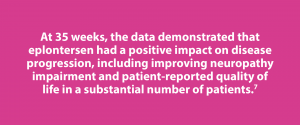15th July 2022
Eplontersen achieves positive interim results in rare disease trial

Eplontersen emerges as an ATTRactive candidate for hereditary transthyretin amyloidosis with polyneuropathy following Phase III clinical trial
Hereditary transthyretin amyloidosis (ATTR) with polyneuropathy is a debilitating condition that arises due to changes – or mutations – in the gene that is responsible for producing the transthyretin (TTR) protein.1,2 This leads to a build-up of TTR amyloid fibrils in the nerves of the peripheral nervous system, although different organs and tissues are also involved such as the heart, kidneys, eyes and the gastrointestinal system.3,4 The clinical features associated with the disease, therefore, are not solely neuropathic and vary greatly between patients.5 As more and more TTR amyloid fibrils build-up, more tissue damage occurs and the disease worsens, resulting in poor quality of life and death typically occurring within 10 years on average.6 Worldwide, there are an estimated 40,000 patients suffering from ATTR with polyneuropathy.4
What is eplontersen?
Eplontersen, is an investigational second-generation RNA-targeted therapy built on Ionis’ ligand-conjugated antisense technology platform. Eplontersen is designed to reduce the production of the TTR protein by halting the translation of TTR RNA into protein, thus potentially preventing the build-up of toxic amyloid fibrils and treating ATTR.
How is eplontersen performing?
Partners AstraZeneca and Ionis Pharmaceuticals have received positive top-line results from a planned 35-week interim analysis of their NEURO-TTRansform Phase III clinical trial in patients with ATTR with polyneuropathy.7
NEURO-TTRansform is a global, multicentre, open-label, randomised trial evaluating the efficacy and safety of eplontersen in adult patients with stage 1 or stage 2 ATTR with polyneuropathy.7-9 In this trial, patients were administered eplontersen via subcutaneous injection once every 4 weeks and compared with the historical placebo arm from the Tegsedi (inotersen) NEURO-TTR trial.8,9

In the trial, eplontersen met its co-primary endpoints:7
√ It reached a statistically significant and clinically meaningful improvement in the percentage change of serum transthyretin concentration, reducing protein production.
√ Eplontersen improved the change from baseline in the modified neuropathy impairment score – a measure of neuropathic disease progression – compared with the external placebo group.
Results also showed that eplontersen met its secondary endpoint, significantly improving patient-reported quality of life versus the external placebo group.7 Furthermore, the therapy demonstrated a favourable safety and tolerability profile with no specific concerns.7
Although the final analyses are yet to be completed, the interim findings look promising. Eplontersen is also being evaluated in the phase III CARDIO-TTRansform study for amyloid transthyretin cardiomyopathy.10
References
1. Benson, M. D., et al. Amyloid nomenclature 2018: recommendations by the International Society of Amyloidosis (ISA) nomenclature committee. Amyloid. 2018;25:215–219
2. Adams D., et al. Hereditary transthyretin amyloidosis: a model of medical progress for a fatal disease. Nat Rev Neurol. 2019;15(7):387–404.
3. Gertz M, et al. Avoiding misdiagnosis: expert consensus recommendations for the suspicion and diagnosis of transthyretin amyloidosis for the general practitioner. BMC Fam Pract. 220;21(1):198.
4. Rintell D, et al. Patient and family experience with transthyretin amyloid cardiomyopathy (ATTR-CM) and polyneuropathy (ATTR-PN) amyloidosis: results of two focus groups. Orphanet J Rare Dis. 2021;16:7.
5. Adams, D. et al. Hereditary transthyretin amyloidosis: a model of medical progress for a fatal disease. Nat Rev Neurol. 2019;15;387–404.
6. Planté-Bordeneuve V, Said G. Familial amyloid polyneuropathy. Lancet Neurol. 2011;10(12):1086–1097.
7. Astrazeneca.com [Internet]. Eplontersen met co-primary and secondary endpoints in interim analysis of the NEURO-TTRansform Phase III trial for hereditary transthyretin-mediated amyloid polyneuropathy (ATTRv-PN). Available from https://www.astrazeneca.com/media-centre/press-releases/2022/eplontersen-phase-iii-trial-met-co-primary-endpoints.html Accessed July 2022.
8. Coelho T, et al. Design and Rationale of the Global Phase 3 NEURO-TTRansform Study of Antisense Oligonucleotide AKCEA-TTR-LRx(ION-682884-CS3) in Hereditary Transthyretin-Mediated Amyloid Polyneuropathy. Neurol Ther. 2021;10(1):375-389.
9. ClinicalTrials.gov [Internet]. NEURO-TTRansform: A Study to Evaluate the Efficacy and Safety of Eplontersen (Formerly Known as ION-682884, IONIS-TTR-LRx and AKCEA-TTR-LRx) in Participants With Hereditary Transthyretin-Mediated Amyloid Polyneuropathy. Available from: https://clinicaltrials.gov/ct2/show/NCT04136184. Accessed July 2022.
10. ClinicalTrials.gov [Internet]. CARDIO-TTRansform: A Study to Evaluate the Efficacy and Safety of Eplontersen (Formerly Known as ION-682884, IONIS-TTR-LRx and AKCEA-TTR-LRx) in Participants With Transthyretin-Mediated Amyloid Cardiomyopathy (ATTR CM). Available at: https://clinicaltrials.gov/ct2/show/NCT04136171?term=CARDIO-TTRansform&draw=2&rank=1. Accessed July 2022.
